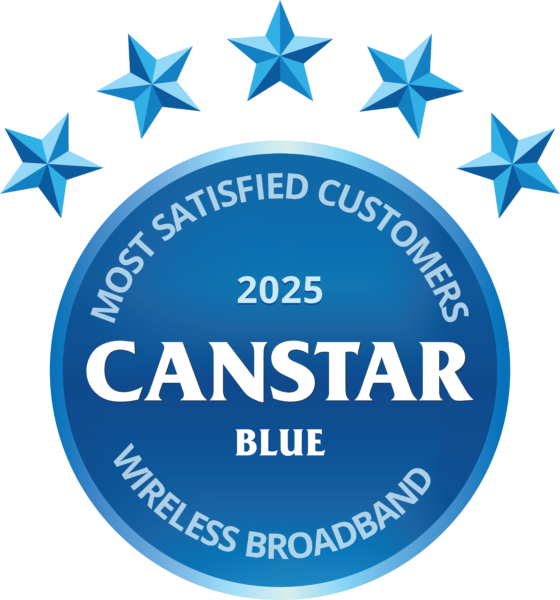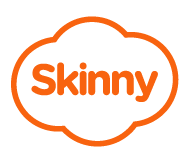Compare wireless broadband providers in New Zealand at Canstar Blue. Skinny, Spark, 2degrees and One NZ were compared on Overall Satisfaction, Bill Clarity, Clarity of Contract, Customer Service, Flexibility of Contract, Network Performance and Value for Money.
See our Ratings Methodology.

Skinny is the winner of Canstar Blue’s Wireless Broadband Award, rated No.1 for customer satisfaction by Kiwi wireless broadband consumers.

Our review compares providers that offer standalone wireless broadband on customer satisfaction, so you can discover what other Kiwis think about our compared wireless broadband providers before you sign on with one of them. Think of it like asking hundreds of your closest friends and family which wireless broadband provider they think is best!
Canstar Blue surveyed 440 Kiwis who have an account with a wireless broadband provider and asked for their feedback on their broadband provider.
Respondents rate their satisfaction with their providers from zero to ten, where zero is extremely dissatisfied and ten is extremely satisfied. Brand satisfaction was rated by respondents on the following criteria:
The winning brand is the one that receives the highest Overall Satisfaction rating once all the scores from the Overall Satisfaction criteria are combined and averaged.
Brands must have received at least 30 responses to be included, so not all brands available in the market have been compared in this survey. The brands rated in this survey are listed below in order of best overall satisfaction.
Find more information on our Most Satisfied Customer methodology.


Given its great value prepaid phone deals, it’s no surprise that Skinny is the only wireless broadband provider in our ratings to earn a top 5-Star rating for Value for Money.
It’s a rating that it achieves across a further four ratings categories, including for Overall Satisfaction, and is why Skinny is the winner of Canstar’s latest Wireless Broadband Award, for delivering the best service, value and satisfaction to Kiwi wireless consumers.
In addition to its no-frills prepaid mobile plans, Skinny offers a great range of broadband deals across fixed and wireless plans.
Free modem on 12-month contract, plus save $10 per month on broadband plans while you have an active eligible Skinny mobile plan:
Average download speeds: 65Mbps.

Sitting in second place, behind its no-frills sister brand, Spark earns a great set of ratings from its customers, including three top 5-Star ratings, one of which is for Customer Service. It receives its lowest rating, 3 Stars, for Value for Money.
Spark offers a similar range of wireless plans as Skinny, but also has a high-speed 5G plan. It’s worth noting that across all plans a modem cost an extra $199, available via interest-free payments, plus $15 delivery.
*Benefits include Netflix Standard ($25.99/month) and McAfee Security Standard ($4.95/month).
Average download speeds: 4G: 64/18Mbps | 5G: 332/49Mbps

2degrees’ no-frills wireless broadband plans deliver the telco company predominantly great 4-Star ratings, for Overall Satisfaction, Network Performance and Value for Money. And in the important category of Customer Service it receives a top 5-Star rating.
2degrees has three wireless broadband plans:
Terms 12-month only, includes free modem ($15 shipping fee). $10/month discount across all plans if you have an eligible 2degrees pay monthly phone plan. Power discounts also available.

One NZ rounds out our wireless broadband ratings and earns a mix of 3- and 4-Star ratings. Although not a top rating, 3 Stars is not a measure of dissatisfaction, rather it shows One NZ’s customers are happy with their wireless provider.
One NZ has three wireless broadband plans:
All plans on 12-month terms with modem included ($15 shipping fee).
Note: All prices correct as of 04/09/2025 and don’t include special offers. For further details, visit individual providers’ websites.

Canstar Blue also rates and reviews Fibre Broadband providers, including Now, Nova Energy, Spark, Skinny, One NZ, Sky, 2degrees and Slingshot. For our latest Fibre Broadband Awards click here.

Many power companies now offer deals that bundle broadband with electricity, these firms include Electric Kiwi, Genesis, Slingshot, 2degrees, Nova Energy, Mercury and Contact. For Canstar Blue’s latest Bundled Utilities Award click here.
Value for Money is usually a top consideration for all consumers in Canstar Blue’s awards, so it’s surprising to see it rated third on our list of top concerns for wireless broadband customers.
The No.1 factor when rating their choice of wireless provider for those in our survey is Customer Service (27%), which beats Network Performance (21%).
And our research reveals that perception plays an important role in how people rate their service. For although Skinny and Spark use the same wireless network, Spark earns a 5-Star ratings for Network Performance, while Skinny’s customers rate their provider 4 Stars.
Overall, here’s what the consumers in our survey say are their most important considerations when rating their wireless broadband providers:

First, it pays to run an internet speed test. This will reveal if it’s a problem with your internet supply.
Then run the test on multiple devices in different parts of your home. If the problem isn’t restricted to just one area of your home, or a particular device, it could be that your household’s data demands could be too demanding for your internet plan (particularly if you’re not on fibre).
For example, 4G fixed wireless only hits around 40Mbps, which can struggle with even a single UHD Netflix stream. Although if you’re on fibre 300 and above, it’s unlikely you’re too demanding for your internet connection, unless you’re really pushing your bandwidth. For even fibre 300 can stream four UHD Netflix shows simultaneously without issue.
If the speed tests reveal your internet is, indeed, the problem, and your speeds are below where they should be, there are a few common reasons for this. Note that the problem could be a combination of a few issues:
Wi-fi routers aren’t the prettiest of devices. As a result, many of us tuck them away out of sight, or set them up in little-used rooms. But this is going to hinder your internet connection. When it comes to a strong wi-fi signal, walls and distances aren’t your friends.
Place your router high up, in an unobstructed location, and near your demanding devices, such as computers, smart TVs and gaming consoles.
Depending on the size of your property (or the density of your walls), it may be that one router isn’t up to the job. If your wi-fi is flying next to the router, but stuttering down the hall and in your bedroom, it may just be the signal is struggling to reach that far.
Wi-fi extenders can help. These don’t extend your wi-fi per se, rather they use your existing wi-fi connection to broadcast their own one. As a result, you’ll have more than one wi-fi network in your home. Your regular network, and the one broadcast by the extender(s).
Mesh routers, on the other hand, deliver a single cohesive wi-fi network that utilises a main router and then several nodes to boost the network around the home.
Mesh routers provide a better internet experience, but are more expensive than wi-fi extenders. However, some providers offer mesh routers as part of their broadband plans.
Router technology is constantly improving. An old router might still connect you to wi-fi, but it may do so at a slower rate. It can also leave your connection open to security risks, and might lack features that could improve your connection.
Modern routers feature a host of features that can improve your home’s wi-fi experience, such as:
If your router is getting old, it could be time to upgrade.
If your router has two networks for you to choose from – 2.4GHz and 5GHz – (as most routers do) this means you have a dual-band router.
Your router uses radio frequencies to transmit internet to your devices, and 2.4GHz and 5GHz refer to the frequency of those radio signals. To get the best out of your wi-fi connection, you need to utilise both in the correct way:
For this reason, it pays to set up your router close to your most demanding devices (gaming consoles, smart TV, work computers, etc.) so they can utilise the 5GHz network.
You can then connect most other things on 2GHz, which is perfect for devices far from the router, as well as things that don’t require much bandwidth. For example, most smart appliances can happily stay on 2GHz, even if they are close to the router.
Furthermore, try plugging demanding devices directly into the router via LAN cables. Not only does this improve the connection to those devices, but it frees up bandwidth for wireless devices. However, this may be impractical if your ONT and router are away from your bandwidth-hungry devices.
 Bruce Pitchers is Canstar NZ’s Content Manager. An experienced finance reporter, he has three decades’ experience as a journalist and has worked for major media companies in Australia, the UK and NZ, including ACP, Are Media, Bauer Media Group, Fairfax, Pacific Magazines, News Corp and TVNZ. As a freelancer, he has worked for The Australian Financial Review, the NZ Financial Markets Authority and major banks and investment companies on both sides of the Tasman.
Bruce Pitchers is Canstar NZ’s Content Manager. An experienced finance reporter, he has three decades’ experience as a journalist and has worked for major media companies in Australia, the UK and NZ, including ACP, Are Media, Bauer Media Group, Fairfax, Pacific Magazines, News Corp and TVNZ. As a freelancer, he has worked for The Australian Financial Review, the NZ Financial Markets Authority and major banks and investment companies on both sides of the Tasman.
In his role at Canstar, he has been a regular commentator in the NZ media, including on the Driven, Stuff and One Roof websites, the NZ Herald, Radio NZ, and Newstalk ZB.
Away from Canstar, Bruce creates puzzles for magazines and newspapers, including Woman’s Day and New Idea. He is also the co-author of the murder-mystery book 5 Minute Murder.
Broadband provides value for money: 61%
Currently subscribe to a paid video streaming service: 49%
Been target of online scam: 32%
Worry about time their children spend online: 17%
Watch <50% TV online: 34%
Watch >50% TV online: 30%
Watch all TV online: 22%
Watch no TV online: 11%
Canstar Blue surveyed 5127 New Zealand consumers across a range of categories to measure and track customer satisfaction, via ISO 26362 accredited research panels managed by PureProfile. The outcomes reported are the results from respondents who have a broadband internet account. In this case, 5037 New Zealanders. Brands must have received at least 30 responses to be included. Results are comparative and it should be noted that brands receiving three stars have still achieved a satisfaction measure of at least six out of 10. Not all brands available in the market have been compared in this survey. The ratings table is first sorted by star ratings and then by mean overall satisfaction. A rated brand may receive a ‘N/A’ (Not Applicable) rating if it does not receive the minimum number of responses for that criterion.

November 28th
Streaming TV services have taken over. Where once Netflix stood alone, countless more have joined. Apple TV+, Disney+, Neon, Prime Video, and even TVNZ+ have all become strong competitors, fighting for a share of our …
– Read more
Below we cover the best deals from mobile phone providers across prepaid and monthly plans. The offers we think deliver the best value are our Deals of the Month!
Deals of the Month: Kogan + Mighty …
– Read more
Below we cover the best deals from broadband providers across fibre and wireless plans. The award we think delivers the best value is our Deal of the Month!
Deal of the Month: Mercury
Mercury is offering six …

One NZ’s SuperWifi broadband deal promises wall-to-wall wi-fi coverage in your home, guaranteed, or you get a $100 credit. So what’s on offer?
Canstar explores One NZ’s SuperWifi broadband deal.
What is One NZ SuperWifi?
One NZ’s SuperWifi …